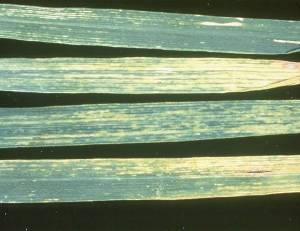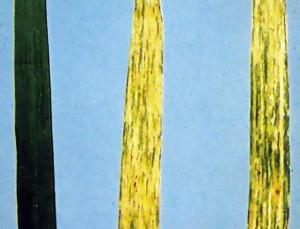Viruses - wheat
Contributors to this page: CIMMYT, Mexico (Etienne Duveiller, Monica Mezzalama, Eloise Phipps, Thomas Payne, Jesper Norgaard), Independent consultant (Jesse Dubin).
|
Contents: |
Barley Stripe Mosaic Virus (BSMV)
Importance
Virus of Gramineae efficiently transmitted through seed. High phytosanitary importance.
Significance
Rare in wheat, causing negligible economic losses. Yield losses are proportional to the level of infection in the seed lot.
Symptoms
Symptoms may vary from very mild stripe mosaic to lethal necrosis depending on the host genotype and environmental conditions (temperatures between 24 and 30°C favor disease development). Symptoms may be confused with barley stripe disease (Pyrenophora graminea).
Infected plants may also exhibit dwarfing, resetting, and excessive tillering.
|
Barley stripe mosaic (photo: CIMMYT) |
Hosts
Natural hosts known are barley, wheat and wild oat.
Geographic distribution
Cosmopolitan
Biology and transmission
No known vectors transmit BSMV. The virus is transmitted through seed, pollen, or direct leaf contact. The main route of natural spread of the virus in the field seems to be by plant-to-plant contact. The seed transmission rate in barley can reach up to 100%.
Mechanical inoculation of the plant species Chenopodium amaranticolor or C. quinoa with the virus produces local lesions, which are useful for detection.
Detection/indexing method
- At CIMMYT: Detection with ELISA using Agdia protocol (http://www.agdia.com).
- At ICARDA: Enzyme-linked immunosorbent assay (ELISA), (TBIA) Tissue Blot ImmunoAssay test
Treatment/control
- No direct treatment available.
Procedures followed at the centers in case of positive test
- At CIMMYT: The seed lot is destroyed.
- At ICARDA: The seed lot is destroyed
EPPO protocols
EPPO Phytosanitary Procedure PM 3/34(1): Barley stripe mosaic hordeivirus. Inspection and test methods for barley seeds. [online] Available from URL: at: http://www.eppo.org/STANDARDS/standards.htm Date accessed 12 March 2010
References and further reading
Albrechtsen SE. 2006. Testing Methods for Seed-Transmitted Viruses: Principles and Protocols. Wallingford, UK: CAB International. 268 pp.
Albrechtsen SE. 1993. Viral diseases. In S.B. Mathur and B.M. Cunfer (eds.), Seed-borne Diseases and Seed Health Testing of Wheat. Copenhagen: Danish Government Institute of Seed Pathology for Developing Countries. pp. 147-151.
Diekmann M, Putter CAJ. (eds.). 1995. FAO/IPGRI Technical Guidelines for the Safe Movement of Germplasm. No. 14: Small Grain Temperate Cereals. Rome: Food and Agriculture Organization of the United Nations (FAO) and International Plant Genetic Resources Institute (IPGRI). pp. 12-13.
Lapierre H, Signoret PA. (eds.). 2004. Viruses and Virus Diseases of Poaceae (Gramineae). Paris: INRA. pp. 456-457.
Lister RM, Carroll TW, Zaske SK. 1981. Sensitive serologic detection of barley stripe mosaic virus in barley seed. Plant Disease 65: 809-814.
Wiese MV. 1987. Compendium of wheat diseases. 2nd edn. St Paul, MN: APS Press. pp. 69-70.
Wheat Streak Mosaic Virus (WSMV)
|
Wheat Streak Mosaic Virus symptoms(WSMV) (photo top: ICARDA, photo middle and bottom: CIMMYT) |
Importance
High phytosanitary importance. WSMV is an important and widely distributed wheat disease with seed transmission. Present in Mexico.
Significance
High economic importance. Losses vary from insignificant to complete.
Symptoms
Infected plants are stunted and develop a rosette appearance. Leaves are mottled and streaked. Leaf streaks are green to yellow, parallel and discontinuous.
Symptoms are not usually apparent in autumn-sown plants or in early spring, but become noticeable when temperatures rise above 10°C.
Hosts
Wheat, maize, millet and various grasses.
Geographic distribution
The USA, Mexico, Europe, parts of Russia, and recently Australia.l
Biology and transmission
Particles of WSMV, a potyvirus, are difficult to purify and quantify. It is terminally inactivated at 54°C.
It is transmitted by the wheat curl mite (Aceria tulipae). Seed transmission was not thought to occur until recently, when the virus was unequivocally shown to be transmitted to a small but consistent proportion of seedlings grown from WSMV-infected wheat plants (Jones et al. 2005).
The disease is severe in areas with a year-round continuum of host plants.
Detection/indexing method
- At CIMMYT: Detection with ELISA using Agdia protocol (http://www.agdia.com).
- At ICARDA: Not applicable
Treatment/control
- No direct treatment available.
- Wheat streak mosaic is controlled by cultural practices that minimize the sources of WSMV and mites at the emergence of new wheat crops, such as the destruction of volunteers.
Procedures followed at the centers in case of positive test
- At CIMMYT: The seed lot is destroyed.
- At ICARDA: Not applicable.
References and further reading
Albrechtsen SE. 2006. Testing Methods for Seed-Transmitted Viruses: Principles and Protocols. Wallingford, UK: CAB International. 268 pp.
CIMMYT. Wheat Doctor information sheet: Wheat streak mosaic virus (WSMV). [online] Available from URL: http://wheatdoctor.cimmyt.org. Date accessed 06 April 2010
Dwyer GI, Gibbs MJ, Gibbs AJ, Jones RAC. 2007. Wheat streak mosaic virus in Australia: Relationship to isolates from the Pacific Northwest of the USA and its dispersion via seed transmission. Plant Disease 91: 164-170.
French R, Stenger DC. 2003. Evolution of wheat streak mosaic virus: Dynamics of population growth within plants may explain limited variation. Annu. Rev. Phytopathol. 41: 199-214.
Jones RAC, Coutts BA, Mackie AE, Dwyer GI. 2005. Seed transmission of wheat streak mosaic virus shown unequivocally in wheat. Plant Disease 89: 1048-1050.
Lapierre H, Signoret PA. (eds.). 2004. Viruses and Virus Diseases of Poaceae (Gramineae). Paris: INRA. pp. 602-604.
Sanchez-Sanchez H, Henry M, Cardenas-Soariano E, Alvizo-Villasana HF. 2001. Identification of wheat streak mosaic virus and its vector Aceria toschella. Plant Disease 85: 13-17.
Wiese MV. 1987. Compendium of wheat diseases. 2nd edn. St Paul, MN: APS Press. pp. 80-81.
Comments
- No comments found





.jpg)



Leave your comments
Post comment as a guest